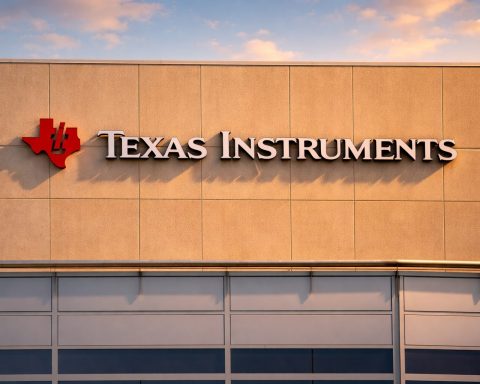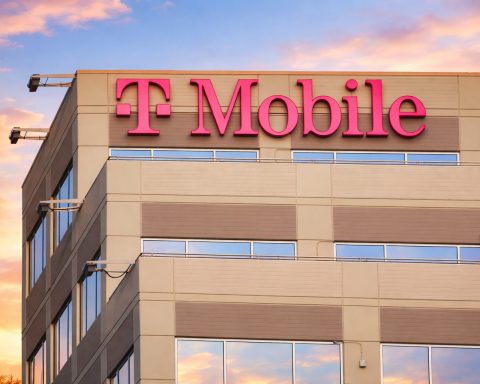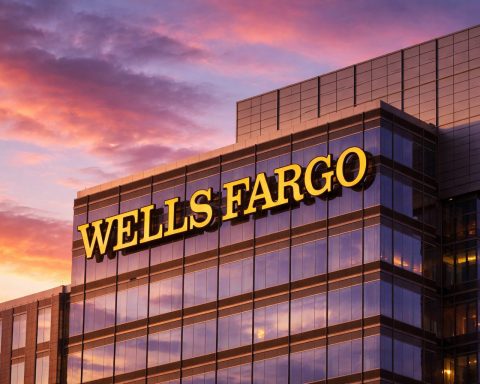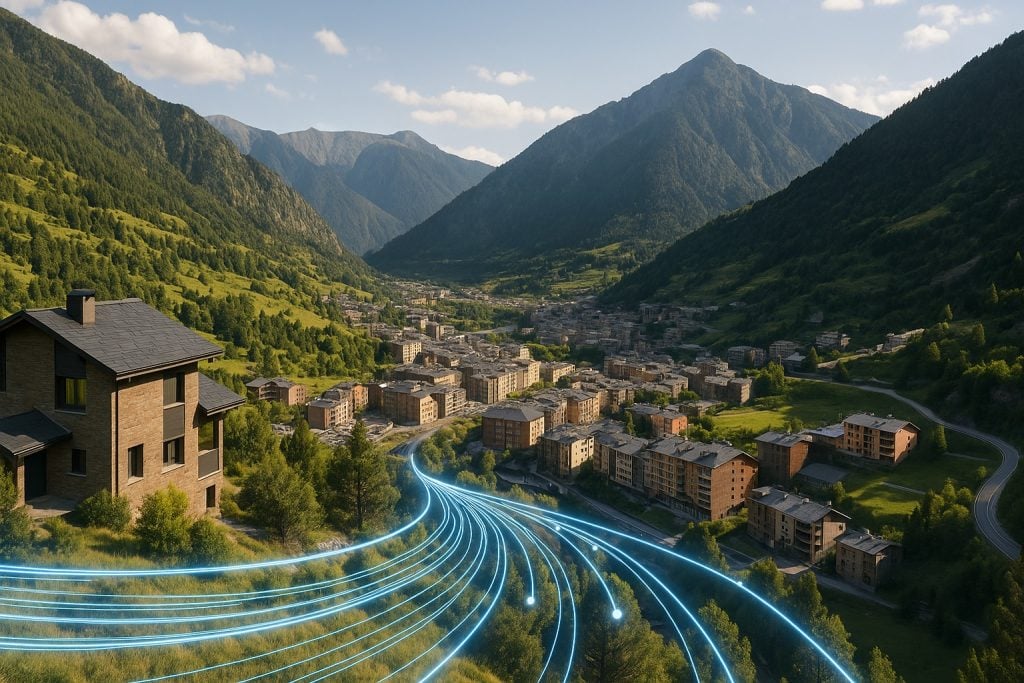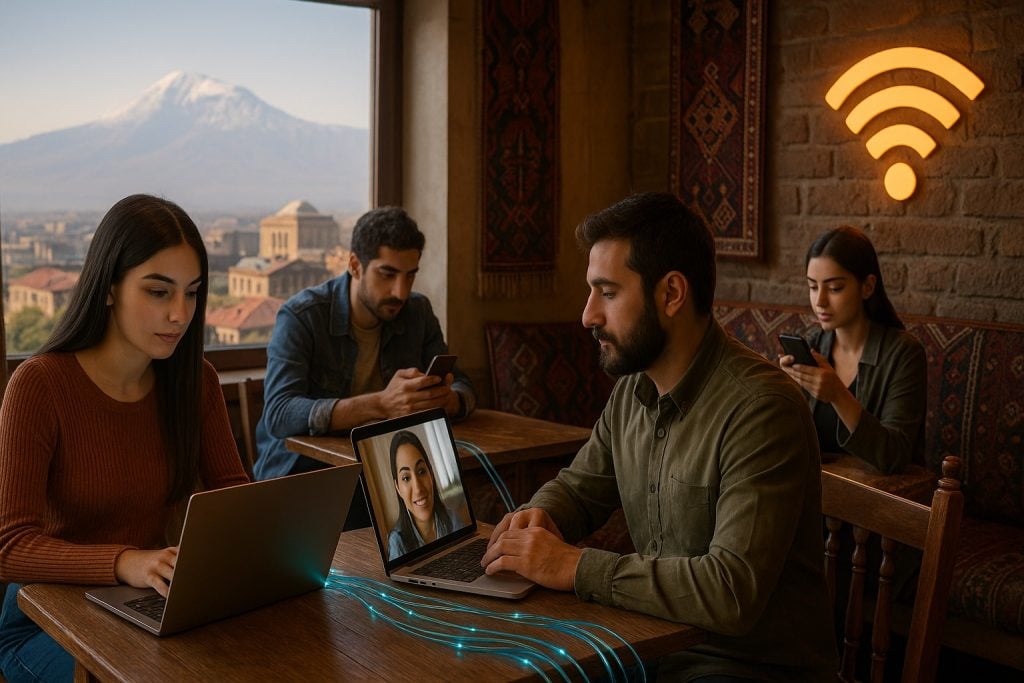- As of January 2025, Angola has about 17.2 million internet users (44.8% penetration) with roughly 60% of the population still offline.
- There are three mobile operators—Unitel (launched 2001), Movicel, and Africell (entered in 2022)—with Unitel and Africell accounting for about 65.7% and 27.8% of mobile broadband subscriptions in 2023, and Movicel the remaining ~6–7%.
- 3G coverage reaches about 90–92% of the population; 4G coverage was around 34% in 2023 with targets of 48% by end-2023 and 85% by 2027, while 5G launched commercially in December 2022 in central Luanda and had ~2% of the population covered by late 2024.
- The Unitel North Submarine Cable opened in February 2023, linking Cabinda to the mainland with fiber to boost connectivity for that exclave.
- Angola’s international backbone includes WACS, SAT-3/WASC, ACE, and SACS, with the 2Africa cable arriving July 2023, ANGONIX Luanda, and a 1,980 km Luanda–Johannesburg terrestrial route completed in 2023 via Liquid Dataport.
- Fixed-line broadband remains small (about 740,000 subscriptions in 2022, ~2% of the population) and Angola Telecom controls roughly 12,000 km of the national fiber backbone out of ~22,000 km, with a 15-year Gemcorp-led concession granted in 2023 and a 2023–2024 restructuring after privatization plans were canceled.
- Mobile data prices have been relatively high (1 GB about $2.33 in 2022, falling to about $1.01 in 2023), with only around 4% of Angolans able to afford 1 GB per month under affordability benchmarks, leading to reliance on public Wi‑Fi and satellite in rural areas.
- Angosat-2, launched in October 2022 and operational in 2023, began providing free internet to public institutions in at least 7 provinces and by late 2023 connected over 150 remote locations, with Conecta Angola deploying VSAT hubs and reaching about 366,000 people by October 2024.
- Beyond Angosat-2, Starlink is expected to launch in Angola in 2025 pending regulatory approval, with a local Starlink Angola entity established, alongside other satellites such as OneWeb, Viasat, and YahClick; Angosat‑2 latency remains around 600 ms as a GEO solution.
- Under the National Development Plan 2023–2027, Angola aims for universal digital inclusion through programs like Conecta Angola, Angola Online, Ilumina Angola, Ngola Digital, and the Broadband Network, with about 50 billion Kwanza allocated and a goal of expanding nearly 2,000 km of fiber plus accelerated 4G/5G rollout, aided by a 2023 Sinohydro/Exim Bank loan package and regulator INACOM’s spectrum allocations (including 3.3–3.7 GHz for 5G) and a 2024 proposed National Security law.
Angola has made significant strides in expanding internet access over the past decade, yet connectivity remains very uneven between its urban hubs and rural hinterlands. With a population of about 37 million [1] – most of them young and over two-thirds living in cities [2] – Angola’s digital landscape is growing rapidly. As of early 2025, roughly 17.2 million Angolans were internet users, representing an internet penetration rate of 44.8% [3]. This is a marked increase from just 32.6% in 2023 [4], reflecting steady growth. However, it also means more than half the population remains offline. For context, Africa’s overall internet usage was only 38% in 2024, far below the global average of 68% [5]. While Angola now slightly exceeds the continental average, it lags behind Africa’s leading nations – for example, Morocco boasts over 92% penetration as of 2025 [6]. Bridging this gap will require addressing economic, infrastructural, and policy challenges that have left rural areas and marginalized communities with limited access.
This report provides a comprehensive overview of internet access in Angola, examining the current state of penetration and usage, the status of mobile and fixed infrastructure, affordability and speeds, the role of government policies, key challenges, the emergence of satellite internet as a lifeline for remote areas, and future opportunities. The target audience – development professionals, telecom investors, and policy researchers – will gain insight into both the progress and the remaining hurdles in connecting all Angolans to the digital world.
Internet Penetration and User Demographics
Internet use in Angola has grown substantially but still has plenty of room to expand. As noted, about 44.8% of Angolans were online by January 2025 [7]. This equates to 17.2 million internet users, up from 14.6 million (39.3% penetration) a year earlier [8] [9]. In other words, roughly 60% of the population is still offline [10]. The growth trend is positive – internet users increased by around 3% from 2024 to 2025 – yet a majority remain unconnected, especially in rural areas and among lower-income groups. Official figures from Angola’s telecom regulator similarly illustrate this rise: President João Lourenço announced that by mid-2024 the number of internet subscribers had reached 11.2 million (about 33% penetration), up sharply from the prior year [11] [12]. (Differences between official and external estimates stem from methodology, but all sources show an upward trajectory in usage.)
Demographically, Angola’s population is very young (median age ~16.6) [13] and predominantly urban (around 69% in cities) [14]. Not surprisingly, most internet users are concentrated in urban centers like Luanda (the capital), where connectivity is more readily available. The urban-rural digital divide is stark: urban internet usage far outpaces rural usage, which remains extremely low due to infrastructure gaps. There is also a multi-SIM culture in Angola – about 28.7 million mobile SIM connections were active in early 2025 (equivalent to 74.6% of the population) [15] [16]. Many individuals use multiple SIMs (e.g. for different providers or work vs personal use), which means the number of connections exceeds the number of unique users. In terms of gender and age, detailed data on internet users is limited, but the youthfulness of the population suggests that younger Angolans drive much of the demand for social media and digital services. (For instance, there were about 5 million social media users in 2024, roughly 13% of the population, with usage skewed toward younger adults [17] [18].) As this digitally savvy young generation comes of age, the pressure to improve internet access across the country will only grow.
In summary, Angola’s internet penetration – roughly 40–45% in 2024/25 – places it in the middle tier among African countries, well below nations like Morocco or South Africa, but slightly above the sub-Saharan African average [19] [20]. The majority of those online are urban, educated, and often use mobile data as their primary access. Expanding usage to the other half of the population, especially rural communities, is the key challenge ahead.
Mobile and Fixed-Line Internet Infrastructure
Mobile networks are the cornerstone of Angola’s internet infrastructure, as in most of Africa. Angola has three mobile network operators (MNOs): Unitel, Movicel, and Africell. Unitel – launched in 2001 – is the market leader and historically held a near-monopoly on mobile internet. Movicel, which started as a state-owned mobile division, became the second operator. In 2022, Africell entered the market as a new competitor, ending the long-standing duopoly. As of 2023, Unitel and Africell together dominate mobile internet service with approximately 65.7% and 27.8% of the mobile broadband subscriptions market, respectively [21]. Movicel accounts for the remainder (roughly 6–7%). The entrance of Africell (a pan-African operator) has been a game-changer – Africell acquired a universal telecom license in 2020 and launched services in April 2022, rapidly gaining subscribers and aiming for nationwide coverage by 2025 [22] [23]. Increased competition is spurring network upgrades and price pressure, though Unitel remains the incumbent with the widest coverage.
Mobile technology and coverage: Angola’s mobile networks currently use a mix of 2G, 3G, 4G LTE, with nascent 5G in limited areas. Third-generation (3G) coverage is nearly universal – about 90–92% of the population is covered by a 3G signal [24]. This extensive 3G footprint (built since the mid-2000s) means basic mobile internet (and voice/SMS) is available in most towns and along major transport routes. 4G LTE, however, has been slow to expand. Unitel and Movicel launched 4G as early as 2012 in urban areas [25], but progress stalled for years. As of 2022, only 44% of the population was within 4G coverage [26]. By 2023, 4G population coverage stood around 34%, though the government expected it to reach 48% by end of 2023 and ambitiously 85% by 2027 [27]. In practice, 4G is currently available mainly in Luanda and other major cities, with operators gradually rolling it out along highways and secondary cities. Gaps in coverage and capacity have led to user complaints about network congestion and instability on 3G/4G networks [28].
Meanwhile, 5G has arrived in pilot form. Unitel launched the first commercial 5G service in December 2022 in central Luanda [29]. During its initial phase, 5G was only available in parts of the capital, offering speeds between 10–200 Mbps and premium-priced plans (15,000 to 125,000 Kwanza, or $30–$245 per month) [30]. By 2023, Unitel had extended limited 5G coverage to two additional provinces [31]. The regulator (INACOM) allocated mid-band 5G spectrum (3.3–3.7 GHz) to all three operators – Unitel, Movicel, and Africell – and each has begun deploying small-scale 5G networks [32] [33]. However, as of late 2024, 5G coverage was still only expected to reach about 2% of the population (mainly urban business districts) [34]. Wider 5G rollout will depend on operators’ investment capacity and consumer demand for high-bandwidth services. The government’s National Development Plan aims for roughly 21% 5G coverage by 2027 [35] – an ambitious goal predicated on significant network build-out.
All operators continue to rely heavily on 2G/3G in rural areas, with 3G being the fallback where 4G is absent. Indeed, Unitel and Movicel were criticized for relying on older GSM/EDGE and 3G networks for too long and being “slow to develop LTE services” until competition increased [36]. Now, with Africell’s entry and government pressure, upgrades are accelerating. Notably, Angola’s government in 2023 prodded Unitel to address “constant network failures,” as users faced dropped calls and slow data due to capacity overloads; Unitel acknowledged it needed to invest more in network expansion and cited difficulty obtaining new equipment because of foreign currency shortages [37] [38]. This highlights how infrastructure quality is a concern even within covered areas – coverage does not always equate to reliable service.
On a positive note, Angola has been investing in backbone infrastructure to support these mobile networks. A major recent project is the Unitel North Submarine Cable, opened in February 2023, which connects the exclave province of Cabinda (separated from the rest of Angola by the DRC) to the Angolan mainland network via fiber optic cables under the ocean [39] [40]. This cable allows high-speed connectivity to Cabinda and Zaire provinces, eliminating reliance on costly satellite or cross-border links, and improving mobile and fixed services in those regions. Additionally, the Ministry of Telecommunications has promoted network sharing and national roaming (through an initiative called “Ilumina Angola”) to improve coverage – operators can potentially share tower infrastructure in remote areas to reduce costs [41] [42].
Fixed-line and broadband infrastructure: Outside of mobile, Angola’s fixed internet infrastructure is comparatively underdeveloped, with low fixed-line penetration concentrated in a few cities. The state-owned Angola Telecom was the monopoly fixed telephone provider until market liberalization in the 2000s [43]. Today, Angola Telecom remains a major wholesale backbone provider and ISP, but it has struggled financially and operationally. The company controls about 12,000 km of the national fiber backbone (out of ~22,000 km of fiber in the country) [44], linking provincial capitals and neighboring countries. However, maintenance and modernization have lagged; Angola Telecom nearly collapsed under debt and was looking to privatize, until the government opted in 2023 to restructure it instead [45] [46]. A 15-year concession was granted to a private consortium (led by Gemcorp) to manage and upgrade Angola Telecom’s transmission network, in hopes of improving efficiency [47]. The government has since cancelled prior plans to fully privatize Angola Telecom but is overhauling its management to revive the operator [48].
In the fixed broadband market, several private ISPs and subsidiaries operate, mostly targeting corporate clients and high-end residential users in Luanda. These include MSTelcom (owned by Sonangol, serving the oil & gas sector), Multitel (an Angola Telecom affiliate focused on enterprise services), TV Cabo Angola (a cable broadband provider jointly owned by Angola Telecom and a private partner), ITA (Internet Technologies Angola), Net One (MSTelcom’s consumer brand), and others [49]. Fixed broadband options range from fiber-to-the-premises in upscale city neighborhoods, to WiMAX/wireless broadband and cable internet. Despite this array of providers, the fixed broadband subscriber base is small – in 2022, INACOM counted only about 740,000 fixed-line internet subscriptions in the country [50]. That’s roughly 2% of the population, indicating that fixed home broadband is a luxury for most Angolans. (By comparison, mobile internet subscriptions were over 9 million at that time [51].) Most fixed lines are in the capital; outside Luanda and perhaps a couple of other cities, fixed broadband availability is scarce or non-existent.
Angola is, however, well-connected internationally via submarine cables. It has leveraged its Atlantic coastline to become a regional connectivity hub. Key undersea fiber optic cables landing in Angola include: the West Africa Cable System (WACS), which Angola Cables (a consortium of Angolan telecoms) co-owns; the SAT-3/WASC cable (partly operated by Angola Telecom); the newer Africa Coast to Europe (ACE) cable; and the groundbreaking South Atlantic Cable System (SACS), which launched in 2018 as the first trans-Atlantic cable linking Africa (Angola) directly to South America (Brazil) [52]. The government and Angola Cables also recently welcomed the arrival of the 2Africa cable in July 2023, a massive consortium-led system encircling Africa; this ended what had been effectively Angola Telecom’s monopoly on wholesale international bandwidth, as now multiple international routes are available [53] [54]. These undersea cables, combined with Angola’s terrestrial fiber links into Namibia, DRC, and Zambia, mean the country has plentiful upstream capacity. (Indeed, Angola Cables operates the ANGONIX Internet Exchange Point in Luanda, which is one of Africa’s larger IXPs, facilitating domestic and regional traffic exchange [55].)
To further boost regional connectivity, a new terrestrial fiber route from Luanda to Johannesburg was completed in 2023 via a partnership between Angola Telecom and Liquid Dataport (part of Liquid Intelligent Technologies). This 1,980 km fiber links Angola with the Democratic Republic of Congo, Zambia, Zimbabwe and South Africa, integrating Angola into Liquid’s 110,000 km pan-African network [56] [57]. The route provides alternative paths to global internet hubs and is expected to improve resilience and reduce latency/costs for connectivity between Angola and the broader Southern African (COMESA) region [58] [59]. The Minister of Telecommunications, Mário Oliveira, lauded such public-private partnerships and noted that Angola has invested heavily in terrestrial, submarine, and even satellite connectivity over 25 years, recognizing telecom infrastructure as critical for modernizing the economy [60].
In summary, Angola’s internet infrastructure is a mix of strengths and weaknesses. Mobile networks cover most of the population, but high-speed 4G/5G coverage is still mostly confined to urban locales. Fiber backbone and international connectivity are relatively strong (thanks to cables and strategic investments), yet the “last-mile” access for average citizens is mostly via mobile, as fixed broadband is neither widely available nor affordable for the masses. The next sections will delve into how this translates into actual service quality, affordability, and the user experience.
Affordability, Accessibility, and Internet Speeds
Despite improvements in infrastructure, internet access in Angola remains expensive for many citizens, and speeds are modest by global standards. High costs and limited purchasing power are significant barriers to connectivity, especially in rural areas and among low-income households.
Cost of internet: By regional standards, Angola’s internet prices are on the high side. In 2023, the average monthly cost of a fixed broadband subscription was about $78.50 – among the highest in Southern Africa [61]. (This was the average for a basic fixed-line broadband plan, according to an international price comparison.) By 2024, that average broadband cost had come down to roughly $47.50 per month [62], but it is still steep in a country where gross national income per capita is around $3,000. Mobile data is relatively more affordable but not cheap: the average price of 1 GB of mobile data was $2.33 as of April 2022 [63], and had fallen to about $1.01 per GB by August 2023 [64]. While a dollar or two may sound inexpensive, it must be seen in context of local incomes – only around 4% of Angolans can afford 1GB of data per month (using the “1 for 2” affordability benchmark of 1GB costing no more than 2% of monthly income), compared to 23% Africa-wide [65]. In other words, for the vast majority of Angolan households, even a basic data plan is a financial strain. The Alliance for Affordable Internet and UN agencies recommend that 1GB cost <2% of average income; Angola is far from that target. Rural and low-income users often must ration their data usage or rely on public Wi-Fi hotspots (when available) to get online.
The government and private sector have introduced some measures to improve affordability and access: free public Wi-Fi hotspots (under programs like “Angola Online”) have been set up in certain urban parks, plazas, and schools [66] [67]. These hotspots have seen high usage – sometimes overwhelming demand – indicating a strong appetite for connectivity if it’s free. However, issues like power outages, vandalism, and maintenance challenges have plagued these initiatives, limiting their reliability [68] [69]. Some mobile operators also offer social bundles or zero-rated access to certain educational or government sites. Still, for truly remote communities, neither mobile coverage nor Wi-Fi hotspots exist – which is where satellite solutions (discussed later) are being tried to fill the gap.
Internet speeds and quality: In terms of performance, Angola’s internet speeds are improving gradually but remain modest. At the start of 2024, median mobile data download speed was about 13.99 Mbps (megabits per second) [70], and by early 2024 it had actually dropped to around 12.7 Mbps [71]. Upload on mobile was around 8–9 Mbps [72]. Median fixed broadband download speed was slightly better at ~19.6 Mbps as of January 2024 [73], rising to about 23.2 Mbps by January 2025 [74]. These speeds are serviceable for basic web use and streaming, but notably below global averages (Angola’s mobile median is less than half the global median, and fixed median less than one-tenth of the global median [75]). The relatively slow speeds reflect the prevalence of older 3G networks and congested 4G cells in many areas, as well as the limited adoption of fiber-to-the-home (which can offer much higher speeds). It’s worth noting that Angola’s fixed speeds did improve about +18% from 2024 to 2025 [76], likely due to new fiber deployments and upgrades in urban centers. Mobile median speeds, however, saw a decline of about 28% during 2023 [77], perhaps due to more users crowding onto networks or technical issues – a reminder that quality can fluctuate.
Urban users in Luanda generally experience the best speeds. For example, in early 2023, Luanda’s average mobile download was measured at 22.4 Mbps [78], significantly higher than the national median. But in rural areas, users often report much lower throughput and frequent network outages. Rural connectivity is hampered by poor infrastructure at multiple levels: fewer cell towers (often only 2G/3G), inconsistent electricity to power those towers (and to charge users’ devices), and long microwave backhaul links that can be unstable. As Freedom House reported, rural voice and data services in Angola suffer “frequent cuts and extremely slow connection speeds,” whereas urban areas at least have more stable electricity and coverage density [79]. The stark urban-rural disparity in ICT was also evidenced by the fact that only 7.3% of rural households had electricity as of 2018, versus 75% of urban households [80] – without power, there is no connectivity, illustrating how basic infrastructure must go hand-in-hand with internet expansion.
Pricing vs. quality: Because of the high prices, many Angolans opt for cheaper plans that unfortunately come with restrictions. Lower-cost bundles from providers like Movicel or NetOne often have very limited data caps or lower priority service, meaning users get “inferior speeds and overall lower service quality” on those plans [81]. This creates a digital divide even among those who are connected – a small minority can afford high-speed unlimited plans (or new 5G home broadband packages), while the majority must settle for slow, metered connections. The government hopes that more competition will drive prices down: the advent of Africell has already led to promotional discounts and better value bundles in some cases. Moreover, new infrastructure (like the 2Africa subsea cable and Angosat-2 satellite) is expected to increase supply of bandwidth and “offer more competitive prices for service” [82] in the coming years, as the next section discusses.
In summary, accessibility in Angola isn’t just about coverage on the map – it’s about economic accessibility. The combination of high costs, patchy quality, and relatively slow speeds means that even where internet is available, it may not be usable or affordable for all. Efforts to improve affordability (through policy or tech innovation) are crucial to ensure that ordinary Angolans can fully benefit from the infrastructure that’s being put in place.
Government Policy and Investment in Expanding Access
The Angolan government plays a central role in the telecom sector – as a policy-maker, regulator, investor, and sometimes owner of telecom companies. In recent years, the government has pursued a two-pronged strategy: infrastructure investment and market reform. The aim is to expand coverage to underserved areas while also injecting competition and efficiency into a historically state-dominated industry.
National Digital Strategy: Under the National Development Plan 2023–2027, Angola launched an ambitious strategy to achieve universal digital inclusion. At a 2025 telecom forum, officials outlined several government-backed programs driving this digital push [83]:
- Conecta Angola – expanding telecom infrastructure and public internet access points, especially in remote areas.
- Angola Online – increasing connectivity for schools, government offices, and public spaces via free Wi-Fi hotspots.
- Ilumina Angola – promoting shared infrastructure and national roaming agreements to improve mobile coverage and competition (so operators can use each other’s towers in underserved zones).
- Ngola Digital – enhancing digital public services and accessibility (e-government initiatives).
- Broadband Network – building out a national high-speed fiber optic backbone across all provinces.
- Digital.AO – advancing digital government platforms and services (a government cloud).
- National Space Program – leveraging satellite communications (e.g. Angosat) to reach areas lacking terrestrial networks. [84] [85]
The government has reportedly earmarked 50 billion Kwanza for these efforts [86]. Concrete targets by 2027 include: achieving over 90% 3G coverage, dramatically boosting 4G and 5G coverage (the official target in one plan was only 32% for 4G and 21% for 5G [87], though as noted, another source cites 85% 4G as a goal [88]). Regardless of the exact figures, the thrust is clear – extend the network to rural communities and modernize to newer technologies. The National Broadband Network project, in particular, involves deploying nearly 2,000 km of new fiber optic cables to link remote regions [89]. The government also is implementing a “Government Cloud” to centralize services, which depends on connecting all municipalities via fiber.
Public investment and foreign partnerships: The government has actively sought financing and partnerships for infrastructure. In January 2023, it signed a contract with Sinohydro (a Chinese firm) with backing from China’s Exim Bank to roll out a National Broadband Network of fiber links [90]. An additional $248 million loan was secured in late 2023 to buy equipment for this project [91]. The goal is to improve speeds and lower internet costs in remote areas by building domestic backbones that reduce reliance on expensive satellite or foreign transit [92]. We’ve already discussed the Liquid Intelligent partnership for cross-border fiber – another example of aligning with international players. The Minister of Telecom has emphasized new laws that provide incentives for such public-private partnerships, aiming to “drive our national focus towards IT-driven modernization” [93].
Market liberalization and privatization: Historically, Angola’s telecom sector was dominated by state-owned or politically connected firms. In recent years, the government has moved to open the market and reduce the state’s direct role. Key moves include the licensing of Africell (bringing in a foreign operator to compete) and plans to privatize stakes in incumbent companies. In 2019, a privatization program was launched listing several telecom assets for sale – Multitel, Net One, Unitel, TV Cabo Angola, and MSTelcom among them [94]. Progress has been mixed:
- Unitel, the mobile market leader, had a fragmented ownership with significant stakes held by the family of former President José Eduardo dos Santos. In 2022, authorities seized a 25% Unitel stake from a Dos Santos ally and another 25% from Isabel dos Santos (the former president’s daughter) due to legal proceedings [95]. These shares were transferred to the state. The government then announced plans to reprivatize Unitel via an IPO (initial public offering), aiming to sell off state-held shares to investors [96]. As of early 2024, an IPO for Unitel was being prepared [97] – a move that could bring more transparency and investment to the company, while eliminating direct state/political control. Officials indicated Unitel’s privatization would start in 2023 and possibly conclude with an IPO in 2024 [98]. If successful, Unitel would transition from a quasi-state incumbent to a publicly traded company, presumably with broader ownership.
- Angola Telecom was slated for partial privatization too, but as noted, the plan changed. After contracting out its network management to Gemcorp in 2022 [99], the government in mid-2023 scrapped the idea of privatizing Angola Telecom and instead is restructuring it internally [100]. The company’s entire board was dismissed by President Lourenço in early 2024 as part of this shake-up [101]. The state seems to be retaining Angola Telecom as a strategic asset (likely due to its backbone and international cable holdings), but with hopes to turn it around operationally.
- Other ISPs: Multitel (the Angola Telecom affiliate ISP) was scheduled for an IPO in 2023 [102], and TV Cabo (the main cable broadband provider) was approved for a 49% stake sale via IPO as well [103]. By August 2023, the government laid out timelines to sell off parts of Multitel, Angola Telecom, and TV Cabo by end of 2023 [104] and MSTelcom in 2024 [105]. It’s not clear if all these sales have occurred as planned, but the intention is to inject private capital and improve service in the fixed broadband sector. Sonangol (the state oil company) currently owns multiple ISPs (MSTelcom, Nexus, ACS) and even 50% of Unitel [106]; the state’s policy is to gradually divest these holdings to encourage a more competitive, market-driven telecom sector.
In summary, government policy is balancing investment in public infrastructure with liberalization to attract private sector efficiency. The regulator, INACOM, has also been active in updating frameworks – for instance, allocating spectrum for 5G, regulating quality of service, and pushing operators to meet coverage obligations. A noteworthy regulatory development is a proposed National Security law (introduced in early 2024) that would grant authorities the power to disrupt telecom services in “exceptional circumstances” [107]. Critics argue this could be misused to shut down the internet for political reasons [108]. While not directly related to expansion, it shows the government’s view of the internet as a critical resource that it wants ultimate control over in emergencies. So far, Angola has not experienced politically motivated nationwide internet shutdowns, and censorship online is limited (the internet is considered “partly free” by Freedom House). The hope is that increased private sector involvement and regulatory independence will continue alongside infrastructure growth, to ensure both openness and progress.
Government initiatives in action: One tangible outcome of policy is the Conecta Angola project (mentioned earlier). Launched in 2023 by the Telecom Ministry (MINTTICS), Conecta Angola is installing free internet access points via satellite in communities with no connectivity. The president highlighted in late 2024 that 366,000 people in remote areas (across 14 provinces) were now benefiting from telephone and internet services through Conecta Angola [109] [110]. This project collaborates with local micro-ISPs and leverages the Angosat-2 satellite, exemplifying how government-backed efforts can directly bridge the digital divide at the grassroots. Similarly, the Angola Online free Wi-Fi program, though challenged as noted, has provided internet in public plazas used by students and youths who can’t afford data. These efforts, combined with broader economic reforms, indicate that the Angolan government sees internet access as a catalyst for socio-economic development – enabling e-learning, e-health, e-commerce, and improved governance.
In conclusion, Angola’s government has put digital inclusion high on its development agenda, committing funds and policy support to expand networks. By opening the market to new players and investing in technologies like fiber and satellite, the state aims to ensure that even the most isolated villages eventually get connected. The success of these policies will depend on effective implementation, continued investment, and keeping services affordable for the populace.
Key Challenges: Geographic, Economic, and Regulatory Barriers
Despite the progress and initiatives described, Angola faces formidable challenges in achieving universal, affordable internet access. These challenges are multi-faceted:
- Geographic and Demographic Disparities: Angola’s sheer size (1.25 million km², roughly the size of Texas or France+Spain combined) and varied terrain make infrastructure deployment difficult. The population is unevenly distributed – large in a few coastal and central highland cities, but very sparse in the interior. Vast distances separate some communities. Laying fiber or building cell towers in remote provinces like Cuando Cubango or Moxico (which have dense forests or miombo woodland, and low population density) yields little short-term return for operators. Even within more populated provinces, rural villages can be isolated by poor roads and (until recently) leftover landmines from Angola’s civil war, complicating construction projects. The result is a classic urban-rural divide: urban hubs have multiple backbones, redundancy, and power supply, whereas many rural localities lack even the basic cell coverage or electricity needed for internet. Bridging this gap requires significant capital expenditure and creative solutions (like satellite) since purely market-driven telecom expansion will not quickly reach areas with a few thousand people scattered over hundreds of square kilometers.
- Economic Barriers and Affordability: As discussed, high poverty levels and low affordability are a major barrier. Nearly half of Angolans live below the poverty line. Even if a village has cell coverage, many residents might not afford smartphones or data plans. Affordability is linked to broader economic issues – Angola’s economy, while bolstered by oil revenues, has struggled with high inflation and unemployment in past years. The local currency (Kwanza) has seen depreciation, making imported telecom equipment and devices more expensive. The scarcity of foreign currency was noted by Unitel as hindering their ability to buy network gear in 2023 [111]. For end-users, the cost of a compatible device (smartphone, 4G router, etc.) is itself a hurdle. The government’s efforts to bring down prices via competition and possibly subsidies (e.g., removing certain telecom taxes or promoting low-cost smartphones) will be critical. Without improving the average Angolan’s purchasing power or lowering price points, connectivity will remain a luxury for many.
- Infrastructure and Power: Beyond telecom-specific infrastructure, Angola’s general infrastructure deficits constrain internet expansion. Electricity supply is unreliable and not universally available, as noted with rural electrification under 10% [112]. Frequent power outages even in Luanda force telecom sites to rely on generators, adding cost and complexity. Rural base stations need solar panels or generators, which is an operational challenge. Additionally, the backbone network has single points of failure – illustrated starkly in August 2023 when undersea currents in the Congo River canyon broke all three submarine cables (WACS, SAT-3, and ACE) that connect Angola northwards [113]. For about a month, internet quality deteriorated nationwide until repairs in September 2023 [114]. While traffic was rerouted through the SACS cable to Brazil and satellite links, the incident showed the fragility of connectivity. Building more diverse routes (like the new route through Namibia/SA and the 2Africa cable) should help. Within the country, many provinces are served by a single fiber route; a cut can isolate an entire region. Seasonal heavy rains and occasional sabotage or theft of cables pose risks. The government’s fiber backbone project aims to create ring topologies and multiple paths to mitigate these vulnerabilities.
- Regulatory and Institutional Challenges: Angola has been reforming, but remnants of the old structures pose challenges. The fact that the state (or state-owned companies like Sonangol) still owns large stakes in operators and ISPs [115] can lead to conflicts of interest or less competitive urgency. While INACOM is the regulator, historically the close ties between government elites and telecom firms (Unitel’s ownership by Dos Santos family, etc.) may have slowed truly consumer-friendly regulation. There are also bureaucratic hurdles – obtaining permits to lay fiber or build towers can be slow, and import duties on equipment add costs. On the positive side, Angola improved some indices for ease of doing business before, but investors still perceive risk in a market where politics and business mix. Ensuring a level playing field for newcomers like Africell and any future entrants (like ISPs for Angosat services) will be important. The government’s push to privatize and remove direct political ownership is addressing this, but it’s a work in progress. Additionally, digital literacy is a softer challenge: large segments of the population, especially older adults or those in rural areas, lack familiarity with the internet’s benefits and skills to use it. This requires public education and local language content to drive meaningful usage once access is provided.
- Economic Dependence and External Shocks: Angola’s economy is heavily oil-dependent. Fluctuations in oil prices affect government revenue and currency stability, which in turn affect telecom investment. During oil price slumps, funding for projects like the National Broadband Network or Conecta Angola could face cuts. Diversifying the economy (one of the reasons Angola is pushing ICT development) is a long-term process. Also, global events (like the COVID-19 pandemic) showed that connectivity is crucial for resilience, but also that Angola’s connectivity was insufficient outside cities – many students and workers in rural areas simply could not participate in remote learning or work during lockdowns, exacerbating inequalities. This lesson adds urgency to closing the gap.
In summary, Angola’s challenges in expanding internet access span the physical (distance, terrain), the economic (cost and poverty), and the institutional (market liberalization and capacity). The government recognizes these issues and has programs to tackle each, but progress will likely be incremental. For the hardest-to-reach communities, traditional market economics will not deliver connectivity anytime soon – which is why alternative approaches like satellite are so important, as discussed next.
Satellite Internet: Connecting Remote and Underserved Regions
To reach Angola’s most isolated regions, satellite internet has become a crucial component of the country’s connectivity strategy. While terrestrial networks (fiber, towers) spread outward from urban centers, satellites can leapfrog infrastructure to deliver links directly to far-flung communities. Angola has invested in its own satellite program and is also looking to global satellite providers to supplement coverage.
Angosat-2 – Angola’s communications satellite: In October 2022, Angola launched Angosat-2, a geostationary communications satellite, into orbit [116]. This satellite was built in partnership with Russia to replace the failed Angosat-1 and carries transponders in C-band, Ku-band, and Ka-band for telecommunications and broadband [117] [118]. Angosat-2 became operational in 2023, and the government promptly began leveraging it to extend internet services. By early 2023, Angosat-2 capacity was already being used to provide free internet connectivity to public institutions in at least 7 provinces – including Uíge, Cuando Cubango, Huíla, Cabinda, Moxico, Lunda Sul, and parts of Luanda [119]. Schools, hospitals, and local administration offices in those areas received satellite terminals, giving them broadband access for the first time. This aligns with the National Space Strategy’s goal of “bridging digital gaps…especially for remote and underserved communities” [120]. For instance, an agricultural technical institute in rural Moxico province began using Angosat-provided internet for e-learning, a transformative change for students there [121].
By late 2023, the Angolan government reported that Angosat-2 was connecting over 150 remote locations across the country [122]. These include villages and municipal centers previously completely offline. The satellite is multi-beam and uses Ka-band spot beams over Angola, which allow higher throughput per user compared to older broad-beam satellites [123]. One challenge was that Angola had no Ka-band gateway on the ground initially, which was resolved by setting up a gateway at the national space program office (GGPEN) in Luanda with support from technology partners [124] [125]. Now that ground infrastructure is in place, Angosat-2 can support both public initiatives and commercial services.
Conecta Angola and satellite ISPs: The Conecta Angola project (2023) mentioned earlier is effectively the deployment of VSAT (Very Small Aperture Terminal) satellite internet hubs using Angosat-2. The project envisions at least two internet access points in each of Angola’s 18 provinces, focusing on remote localities [126]. These access points typically consist of a satellite dish and Wi-Fi hotspot that communities can use. As of October 2024, Conecta Angola had benefited about 366,000 people who now have telephone and internet access via satellite [127]. President Lourenço emphasized that this initiative, “powered by the Angosat-2 satellite,” is pivotal for ensuring no region is left completely disconnected [128]. The project also encourages private small businesses to participate – local entrepreneurs or cooperatives can manage the satellite access points and offer services, a model to spur bottom-up connectivity [129].
From a commercial standpoint, Angosat-2 was opened to telecom operators in 2023. The government began “commercialization” of Angosat-2 capacity in February 2023, inviting national and international operators to lease bandwidth [130]. The idea is that mobile operators can use satellite backhaul to extend cell service to rural areas, or ISPs can use it to serve customers where fiber/microwave backhaul is unavailable. Notably, Angola’s MSTelcom (Mercury Telecommunications) – a Sonangol subsidiary and major ISP – was an early adopter. MSTelcom, in partnership with ST Engineering iDirect, activated the first Ku-band beams of Angosat-2 and started offering broadband connectivity via VSAT to enterprise clients [131] [132]. They had to overcome technical hurdles (like using a multi-band payload and setting up a Ka-band gateway), but succeeded in creating a platform where both large and smaller operators can purchase satellite bandwidth more easily [133] [134].
One significant advantage touted is that Angosat-2’s capacity is sold in local currency (Kwanza) within Angola [135]. This shields Angolan ISPs from exchange rate volatility and makes budgeting easier, hopefully translating to more affordable end-user prices. Prior to Angosat-2, any satellite internet in Angola relied on foreign satellites (often priced in USD or Euro), and capacity was costly. By having a national satellite, Angola aims to cut those costs. Indeed, officials said Angosat-2 should help “offer more competitive prices” and reduce the digital divide by allowing “equal access to all Angolans” via its coverage [136]. The satellite’s beams cover all of Angola (and even surrounding regions), meaning even a tiny village can theoretically be connected with a small dish and modem.
Starlink and other LEO constellations: In addition to its own satellite, Angola is looking toward collaboration with low-Earth-orbit (LEO) satellite broadband providers. SpaceX’s Starlink, which provides high-speed internet via a constellation of low-orbit satellites, has been expanding across Africa. As of early 2025, Starlink service is live in about 20 African countries and expected to launch in many more by the end of 2025 [137] [138]. Angola is anticipated to get Starlink in 2025, pending regulatory approval [139]. In fact, SpaceX has reportedly established a local entity (“Starlink Angola”) and was awaiting an operating license from INACOM [140]. However, there have been delays – some reports in 2024 suggested the government was cautious about Starlink, possibly to protect Angosat-2’s market or to ensure regulatory control [141] [142]. Despite any behind-the-scenes hesitation, it is likely that Starlink will eventually be authorized, as Angola would not want to be left out of a technology that could greatly benefit remote connectivity. If/when Starlink goes live, users in Angola (particularly in rural/remote areas) could access extremely fast internet (100+ Mbps) with just a satellite dish kit. The cost is still relatively high (Starlink hardware and monthly fees might be beyond the reach of average rural households without subsidies), but it can be transformative for businesses, schools, or community hubs in isolated regions. Notably, neighboring countries like Mozambique, Zambia, and Zimbabwe have already launched Starlink in 2023-2024 [143] [144], and even conflict-affected countries (Somalia, DRC) have granted licenses recognizing satellite’s value in hard-to-serve areas [145] [146]. Angola is on track to join this trend.
Apart from Starlink, other satellite services are available or emerging: OneWeb, another LEO constellation, has partnered with pan-African telecom groups and could offer services in the region in the near future. Viasat (which now owns the older Inmarsat and has launched new Viasat-3 satellites) could also target Angola for rural connectivity solutions. In the medium Earth orbit (MEO) segment, SES’s O3b network has provided high-throughput links to African operators and could be an option for Angolan telcos needing backhaul in remote areas. And even earlier, Angolans have had access to classic VSAT services: for example, YahClick (by Yahsat from UAE) partnered with an Angolan ISP back in 2013 to offer Ka-band satellite broadband, touting for the first time that satellite internet was “affordable” for Angolan home users [147] [148]. YahClick and similar services (like Eutelsat’s Konnect service) continue to be available, typically serving NGOs, businesses or wealthy users in rural locales. These services require installing a ~1.2m dish and subscribing to data plans – which are still pricey per GB, but can connect a site anywhere under the satellite’s footprint. For instance, YahClick via local partner Global Telesat targeted both home and business users in areas “with no further infrastructure requirements” – just a small dish and modem [149] [150]. Such offerings, alongside Angosat-2’s own services, mean that no part of Angola is truly unreachable if there is a will and budget to connect it.
The role of satellite in Angola’s future: In essence, satellite internet serves as a “lifeline” for Angola’s most underserved regions, complementing the ground networks. The government’s strategy smartly integrates satellite as one pillar (through the National Space Program and Angosat), rather than seeing it as competition to terrestrial networks. Angosat-2 is not just a prestige project; it’s directly enabling telemedicine in rural clinics, distance learning in village schools, and connectivity for administrative posts that can now communicate without driving hours to the nearest town. Private sector involvement in satellite will further enrich the ecosystem – for example, mobile operators can use satellites for backhaul to expand 4G coverage to a remote town without waiting to extend fiber to it, and mining or agricultural enterprises in the interior can get reliable internet via satellite to power their operations.
One can envision hybrid solutions too: e.g., a rural cell tower connected via Angosat or Starlink backhaul providing a local 4G signal to surrounding villages. Or community Wi-Fi hotspots fed by a high-throughput satellite link, as Conecta Angola is doing. As technologies advance, even smaller, cheaper satellite user terminals (like flat-panel antennas) may appear, reducing the cost barrier.
Of course, satellites come with challenges: latency (for GEO like Angosat-2) is high ~600ms, which is not ideal for certain applications (though fine for browsing, streaming). LEO systems have lower latency (~50ms) but require many satellites and handoffs, and user terminals still cost a few hundred dollars. And capacity, while improving, can be expensive if not scaled. But overall, satellite is currently the most viable option to connect the last 20–30% of Angola’s population that are out of reach of fiber and towers. It truly acts as a “lifeline” by providing at least a basic level of connectivity where none existed, and in emergencies it offers backup connectivity if terrestrial networks fail (for disaster recovery or cable cuts).
In summary, Angola’s embrace of satellite internet – through its own Angosat-2 and upcoming services like Starlink – is a critical element in achieving nationwide access. It reflects a pragmatic approach: combining all available technologies (fiber, microwave, mobile, and satellite) to extend the internet’s reach from the bustling urban hubs of Luanda to the most isolated rural communities deep in the countryside.
Opportunities for Future Development and Investment
Looking ahead, there are several promising opportunities and trends that could accelerate internet development in Angola. These opportunities involve technological innovation, private sector investment, and regional positioning:
1. Completion of Ongoing Infrastructure Projects: In the near term, a major opportunity lies in finishing and fully leveraging the infrastructure projects underway. The National Broadband fiber network financed by China, once completed, will link provincial capitals and many municipalities with high-speed fiber. This can drastically reduce backhaul costs for mobile operators and ISPs, enabling them to offer cheaper and faster connections locally. Similarly, as the 2Africa submarine cable and the new routes through Namibia/DRC become fully operational, Angola will have abundant international bandwidth with redundant paths. This should improve reliability (no more total dependency on one cable) and could drive down IP transit prices through competition. Investors in data-intensive services (like data centers or content delivery networks) will find a more robust infrastructure to build on. In fact, Angola Cables has been expanding data center capacity (the AngoNAP Luanda facility) and positioning Luanda as a connectivity hub between Africa and South America – an attractive proposition for global cloud and tech companies to cache content or route traffic via Angola. Angola’s strategic geography and cable links mean it can monetize transit traffic and become a regional internet exchange point for southern Africa. This hub status could bring in revenue and better service for local users.
2. 5G and Technological Leapfrogging: As 5G networks gradually expand, Angola has an opportunity to leapfrog in certain services. While widespread 5G coverage is years away, targeted deployments can enable advanced use-cases in key sectors. For example, the oil & gas industry or ports (like the Port of Luanda) could use 5G for IoT and automation, improving efficiency. The government could also deploy 5G (or enhanced 4G) in tech parks or university campuses to spur innovation (startups working on virtual reality, telemedicine, etc., that require high bandwidth). Fixed Wireless Access (FWA) is an immediate opportunity: instead of laying copper or fiber to homes (which is costly), 5G CPEs (customer premises equipment) could deliver fiber-like speeds wirelessly to homes and businesses in Luanda’s suburbs or secondary cities. This could rapidly increase the number of households with broadband. Africell, for instance, might capitalize on FWA to capture market share by offering home internet over its new LTE/5G network as it rolls out. Such competition could push Unitel and others to improve their offers, benefiting consumers. Equipment vendors (like Huawei, Nokia, Ericsson) might find Angola a receptive market as operators upgrade networks – they may invest in training and development centers locally, which would build skills.
3. Private Sector and Foreign Investment: Continued liberalization and privatization will likely attract more investment. The planned IPOs for Unitel, Multitel, TV Cabo, etc., if executed transparently, could inject fresh capital and know-how into those companies. For example, an international telecom operator or investment fund might buy into Unitel, bringing global expertise. Or Multitel’s IPO could bring in a strategic partner to expand fiber broadband offerings. The Angolan government’s removal of certain monopolies and encouragement of competition (such as licensing a fourth mobile operator or more ISPs) could further open the market. In 2022, there were discussions about a fourth MNO license – if that happens, companies like Vodacom or MTN (major African operators) might be interested, which would further shake up the market. Tower-sharing and infrastructure companies are another area: independent tower companies could invest in building and leasing towers, reducing duplication and expanding rural coverage with lower costs per operator (Angola’s “Ilumina” infrastructure sharing policy helps pave the way [151]). This model has succeeded in other African countries to extend networks.
Additionally, tech and digital services sectors present growth opportunities on top of connectivity: once people come online, there is demand for local content, e-government services, fintech, and e-commerce. Angola already has a few tech startups and mobile money services (e.g., Africell launched AfriMoney mobile wallet [152]). As internet penetration increases, investors may see opportunities in digital financial services (to serve the unbanked), telehealth (reaching patients in remote areas), online education platforms, and content creation (local media, entertainment). The government’s digital platforms (like Digital.AO for e-gov) will create demand for cloud and cybersecurity services – areas where private firms can partner or provide solutions. With Angola’s large youth population, the digital economy could become a significant employer, if nurtured.
4. Regional Integration and Competitive Benchmarking: Angola can look to peer countries for both inspiration and collaboration. For instance, Rwanda’s model of rural connectivity (with universal service funds and public-private partnerships) or Kenya’s thriving mobile money and digital startup scene could offer lessons. SADC (Southern African Development Community) initiatives on roaming and cross-border connectivity might also reduce costs (e.g., one regional SIM or zero roaming charges in the region – an idea being pursued in other parts of Africa). Angola is already connected to Namibia and DRC networks; deeper integration could allow, say, an ISP from Namibia to offer services in southern Angola if regulations permit, spurring competition. Such regional approaches might be far off, but as infrastructure connects, regulatory cooperation can bring consumer benefits.
On the satellite front, once Starlink or similar are authorized, Angola could partner with these providers to cover schools and clinics. For example, SpaceX in some countries has worked with governments to connect schools via Starlink at subsidized rates. Angola could leverage Angosat plus LEO constellations to ensure every school in the country has internet within a few years – a tangible, high-impact goal that development partners (World Bank, UNICEF, etc.) might fund. This would create a more digitally literate generation and increase demand for services.
5. Improving Enabling Environment: Lastly, an opportunity lies in the soft infrastructure – policies and human capacity. Angola can invest in training more ICT professionals, perhaps through coding academies or partnerships with universities. A skilled workforce will attract BPO (business process outsourcing) or tech companies to set up operations (much like how Ghana or Senegal have done). If Angola can reduce bureaucratic red tape and improve indices like the ICT Development Index or World Bank’s Digital Adoption Index, it could signal to investors that the environment is ripe. Continuing to strengthen independent regulation, consumer protection (so that quality of service remains a priority), and cybersecurity frameworks will also be important as more people come online.
In conclusion, Angola stands at a pivotal moment where smart investments and policies can significantly boost internet access and digital growth. The combination of an engaged government, increasing competition, new infrastructure, and satellite augmentation creates a positive outlook. Challenges remain, but the trajectory is toward greater connectivity. For development professionals, this means opportunities to support digital inclusion programs (telemedicine, e-learning in connected villages, digital literacy campaigns). For telecom investors, Angola’s relatively untapped market – the tens of millions not yet online – represents a growth frontier, provided they navigate the local context well. And for policy researchers, Angola offers a case study in how a post-conflict, resource-rich nation can leverage both public investment and market mechanisms to transform its digital landscape.
Comparative context: It’s worth noting that many African countries have faced similar hurdles and achieved rapid progress with the right mix of innovation and policy. Just in the last five years, Africa’s overall internet use jumped from 25% to 40% [153]. Angola has roughly doubled its penetration in that time as well, and could accelerate that pace. Countries like Kenya (with ~85% internet penetration via mobile broadband) or Nigeria (over 100 million internet users) show what’s possible in a short time frame when mobile connectivity and affordable services align. Angola’s own unique assets – such as the SACS cable linking to Brazil, making it a gateway between continents – could be leveraged to create a regional digital hub, not just a consumer market.
In summary, the state of internet access in Angola is one of gradual but significant improvement. The urban population is increasingly connected through mobile and fiber, while rural areas are starting to see connectivity through innovative means like satellites. Government vision and private initiative are converging to tackle the gaps. If the current momentum is maintained, Angola can look forward to a future where the phrase “from urban hubs to satellite lifelines” signifies not a gap, but a seamless web of connectivity that spans the entire nation – enabling economic diversification, social development, and a more inclusive digital society.
Sources: The information in this report was gathered from a range of up-to-date official and reputable sources, including DataReportal digital reports [154] [155], Freedom House and World Bank data [156] [157], telecom industry news (TeleGeography, SAMENA, etc.) [158] [159], and statements from Angolan authorities [160] [161]. These provide the latest statistics and insights as of 2024–2025 on Angola’s connectivity landscape, corroborating the analysis above. The comparative African context is drawn from ITU and regional reports [162] to situate Angola’s progress relative to its peers. All citations are included inline for reference.
References
1. datareportal.com, 2. datareportal.com, 3. datareportal.com, 4. satelliteprome.com, 5. techafricanews.com, 6. www.statista.com, 7. datareportal.com, 8. datareportal.com, 9. datareportal.com, 10. datareportal.com, 11. www.menosfios.com, 12. www.menosfios.com, 13. datareportal.com, 14. datareportal.com, 15. datareportal.com, 16. datareportal.com, 17. datareportal.com, 18. datareportal.com, 19. techafricanews.com, 20. www.statista.com, 21. freedomhouse.org, 22. www.budde.com.au, 23. www.budde.com.au, 24. freedomhouse.org, 25. www.samenacouncil.org, 26. freedomhouse.org, 27. www.samenacouncil.org, 28. www.samenacouncil.org, 29. freedomhouse.org, 30. freedomhouse.org, 31. freedomhouse.org, 32. www.budde.com.au, 33. www.budde.com.au, 34. www.samenacouncil.org, 35. globalvalidity.com, 36. www.budde.com.au, 37. www.samenacouncil.org, 38. freedomhouse.org, 39. freedomhouse.org, 40. freedomhouse.org, 41. globalvalidity.com, 42. globalvalidity.com, 43. en.wikipedia.org, 44. freedomhouse.org, 45. freedomhouse.org, 46. freedomhouse.org, 47. freedomhouse.org, 48. freedomhouse.org, 49. en.wikipedia.org, 50. freedomhouse.org, 51. freedomhouse.org, 52. freedomhouse.org, 53. freedomhouse.org, 54. freedomhouse.org, 55. freedomhouse.org, 56. liquid.tech, 57. liquid.tech, 58. liquid.tech, 59. liquid.tech, 60. liquid.tech, 61. freedomhouse.org, 62. freedomhouse.org, 63. freedomhouse.org, 64. freedomhouse.org, 65. freedomhouse.org, 66. freedomhouse.org, 67. freedomhouse.org, 68. freedomhouse.org, 69. freedomhouse.org, 70. datareportal.com, 71. freedomhouse.org, 72. freedomhouse.org, 73. datareportal.com, 74. datareportal.com, 75. freedomhouse.org, 76. datareportal.com, 77. datareportal.com, 78. freedomhouse.org, 79. freedomhouse.org, 80. freedomhouse.org, 81. freedomhouse.org, 82. freedomhouse.org, 83. globalvalidity.com, 84. globalvalidity.com, 85. globalvalidity.com, 86. globalvalidity.com, 87. globalvalidity.com, 88. www.samenacouncil.org, 89. globalvalidity.com, 90. freedomhouse.org, 91. freedomhouse.org, 92. freedomhouse.org, 93. liquid.tech, 94. freedomhouse.org, 95. freedomhouse.org, 96. freedomhouse.org, 97. freedomhouse.org, 98. freedomhouse.org, 99. freedomhouse.org, 100. freedomhouse.org, 101. freedomhouse.org, 102. freedomhouse.org, 103. freedomhouse.org, 104. freedomhouse.org, 105. freedomhouse.org, 106. freedomhouse.org, 107. freedomhouse.org, 108. freedomhouse.org, 109. spaceinafrica.com, 110. spaceinafrica.com, 111. freedomhouse.org, 112. freedomhouse.org, 113. freedomhouse.org, 114. freedomhouse.org, 115. freedomhouse.org, 116. en.wikipedia.org, 117. en.wikipedia.org, 118. en.wikipedia.org, 119. spaceinafrica.com, 120. spaceinafrica.com, 121. spaceinafrica.com, 122. satelliteprome.com, 123. satelliteprome.com, 124. satelliteprome.com, 125. satelliteprome.com, 126. www.telecompaper.com, 127. spaceinafrica.com, 128. spaceinafrica.com, 129. spaceinafrica.com, 130. freedomhouse.org, 131. satelliteprome.com, 132. satelliteprome.com, 133. satelliteprome.com, 134. satelliteprome.com, 135. satelliteprome.com, 136. spaceinafrica.com, 137. mybroadband.co.za, 138. mybroadband.co.za, 139. mybroadband.co.za, 140. www.reddit.com, 141. www.facebook.com, 142. www.menosfios.com, 143. mybroadband.co.za, 144. mybroadband.co.za, 145. mybroadband.co.za, 146. mybroadband.co.za, 147. appablog.wordpress.com, 148. appablog.wordpress.com, 149. appablog.wordpress.com, 150. appablog.wordpress.com, 151. globalvalidity.com, 152. www.budde.com.au, 153. www.ecofinagency.com, 154. datareportal.com, 155. datareportal.com, 156. freedomhouse.org, 157. freedomhouse.org, 158. www.samenacouncil.org, 159. liquid.tech, 160. www.menosfios.com, 161. spaceinafrica.com, 162. techafricanews.com


